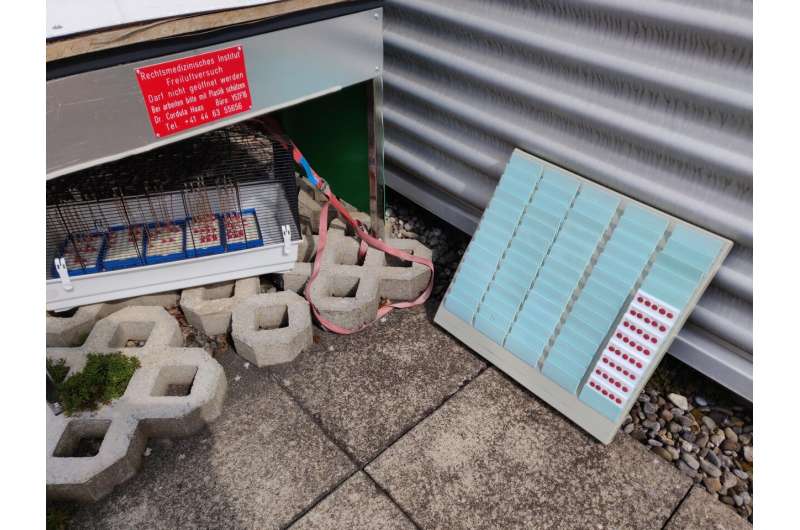This article has been reviewed according to Science X's editorial process and policies. Editors have highlighted the following attributes while ensuring the content's credibility:
fact-checked
peer-reviewed publication
trusted source
proofread
The age of blood stains says more about the crime

The composition of blood stains changes over the course of weeks and months. Forensic medicine hopes to make use of this fact in future to convict suspects—or to prove their innocence.
The blood-stained paper lay on the roof terrace for almost a year, protected from the rain but otherwise exposed to the elements. Fortunately it wasn't evidence of a violent crime; no, the drops of blood were part of a project by the Swiss National Science Foundation. Researchers had set up the long-term study with the aim of developing a forensic method for reliably determining the age of a trace.
This is particularly important if blood, saliva or semen is not discovered until weeks or months after a crime has been committed. At this stage, matching the bodily fluid with a specific person, by DNA analysis for example, is often not enough. It is then also vital to demonstrate that the trace was deposited at the time the crime was committed, and not in a situation before or after which had nothing to do with the crime.
"There is currently no routine method for this kind of age determination," explains Andrea Steuer, Section Head at the Centre for Forensic Pharmacology & Toxicology in the Institute of Forensic Medicine, University of Zurich.
When was the blood stain deposited?
Her team is therefore investigating whether the composition of a blood stain—on the ground or on suspects' clothing, for example—might reveal when the stain was deposited. Biochemical processes start as soon as the blood leaves the protected environment of the body. Some of the components in blood are decomposed or modified, new substances accumulate as breakdown products. It may be possible to use this information to tell how old the evidence is.
The researchers considered two different situations in their study: they dripped blood samples from eleven people onto absorbent paper and stored them either in relatively constant environmental conditions in a laboratory drawer or under a table on the roof of the Institute of Forensic Medicine, where they were exposed to all climatic conditions, such as wind, UV light and fluctuating temperatures, with the exception of rain.
Over the course of 48 weeks they took samples at nine different times and analyzed them with a mass spectrometer, a piece of equipment that separates the substances in the blood on the basis of size and chemical properties.
They found more than 10,000 different substances in the blood samples using this method. "We have no idea what most of them are," Steuer says. But that's not important. The researchers' first objective was to use the enormous volume of data to identify substances of which the amount changes measurably over time. "We can then characterize these possible candidates for age determination in more detail," Steuer explains.
Finding the needle in the haystack
Complex statistical analyses did indeed enable her team to identify several suitable substances. One of the most promising is phenylalanylalanine, a small molecule that may be formed when the proteins in blood break down. Only very small quantities of phenylalanylalanine were present in the blood samples to start with, but they increased continually over time almost up to the end of the experiment.
However, it is still not certain whether a forensic test method can be developed from this observation. For example, the effect of various environmental factors such as air humidity and temperature on the quantity of phenylalanylalanine needs to be tested individually. It is also important to be sure that there are no major differences between blood from different people. "The more you look at the question, the more complex it becomes," Steuer says.
The team is now using the same approach to investigate traces of saliva, semen and urine, although the samples used for this are only stored in the laboratory and not on the roof. "The uncertainty introduced by extreme environmental conditions is simply too great in the open air," Steuer explains. "But even if the method only works indoors, that would still be major progress."
The paper is published in the journal Drug Testing and Analysis.
More information: Tom Dario Schneider et al, Determination of the Time since Deposition of blood‐traces in a forensic context: Application of untargeted LC‐HR‐MS/MS metabolomics profiling, Drug Testing and Analysis (2023). DOI: 10.1002/dta.3480
Journal information: Drug Testing and Analysis
Provided by Fermi National Accelerator Laboratory




















